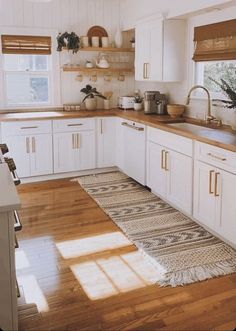Transforming Your Kitchen with Thoughtful Design

Table of Contents
ToggleTransforming Your Kitchen with Thoughtful Design
The kitchen is often considered the heart of the home—a space where cooking, entertaining, and family bonding all come together. Whether you’re remodeling your existing kitchen or designing a brand-new one, a well-thought-out kitchen design can make a world of difference. In this article, we will explore the essential elements of kitchen design, trending styles, and practical tips to create a space that is both functional and beautiful.The Design in Sewing: Creativity Through Fabric and Thread
The Fundamentals of Kitchen Design
Before diving into aesthetics, it’s important to consider the core components of a functional kitchen. A successful kitchen design should seamlessly combine layout, storage, and ergonomics. Here are the key factors to consider:
- Layout and Floor Plan: The layout of your kitchen will dictate how easily you can move between key work areas: the refrigerator, stove, and sink. Popular kitchen layouts include:
- L-Shaped: Ideal for smaller spaces, this layout features a work area that forms an “L” shape, offering plenty of countertop space and a natural flow.
- U-Shaped: This layout is perfect for larger kitchens, providing ample counter space on three sides, making it great for multiple chefs.
- Galley: Also known as a corridor kitchen, the galley layout is efficient, with two parallel counters offering great workflow in compact spaces.
- Island Layout: Incorporating an island into your kitchen provides extra counter space, seating, and even storage, making it a popular choice in modern homes.Design a Gallery Wall That Tells Your Story – Here’s How!
- Workflow and Ergonomics: The kitchen work triangle is a concept that helps design an efficient layout by ensuring that the stove, sink, and refrigerator are placed at optimal distances for easy movement. A thoughtful arrangement will minimize unnecessary steps and make cooking and cleaning a smoother process.
- Storage Solutions: Storage is essential in a kitchen. There are many ways to maximize storage space:
- Cabinetry: Tall cabinets, pull-out drawers, lazy Susans, and built-in dividers can help keep items organized.
- Pantry: A walk-in or pull-out pantry can make storing dry goods and other essentials more convenient.
- Open Shelving: For those who prefer to display dishes or spices, open shelving can add an airy and stylish touch.

Popular Kitchen Design Styles
Choosing a style that reflects your personality and complements your home is an important part of the design process. Some of the most popular kitchen design styles include:
- Modern Kitchen Design: Modern kitchens emphasize clean lines, minimalism, and functionality. This design style often incorporates sleek cabinetry, open shelving, stainless steel appliances, and bold lighting fixtures. Neutral tones like whites, blacks, and grays are commonly used, with pops of color added through accessories or accent walls.
- Traditional Kitchen Design: Traditional kitchens embrace warmth and elegance. They often feature detailed woodwork, ornate cabinetry, and classic finishes. A traditional kitchen might include features like crown molding, raised panel cabinetry, and rich wood tones such as cherry or oak. Classic colors like cream, navy, and burgundy are popular choices.
- Farmhouse Kitchen Design: The farmhouse style evokes a cozy, rustic charm with a focus on practicality. Whitewashed cabinetry, exposed beams, apron-front sinks, and vintage-inspired lighting are staples in a farmhouse kitchen. A farmhouse kitchen often has a welcoming, lived-in feel that makes it ideal for family gatherings.
- Industrial Kitchen Design: Industrial kitchens feature raw, unfinished materials like steel, concrete, and exposed brick. This design often includes open shelving, large factory-style light fixtures, and an emphasis on function over form. It’s a bold, urban style that’s perfect for those who like a bit of edge in their home design.
- Transitional Kitchen Design: The transitional style is a blend of traditional and modern elements. This design typically incorporates clean lines with a more muted or neutral color palette, offering timeless appeal. Transitional kitchens feature custom cabinetry, a mix of materials like wood and stone, and often prioritize comfort while maintaining a chic, sophisticated feel.

Key Design Elements for a Beautiful Kitchen
- Color Scheme: Your kitchen’s color palette plays a crucial role in setting the mood of the space. Soft neutrals like beige, gray, and white are popular for creating a calm and clean atmosphere. If you prefer a pop of color, accent hues such as navy, sage green, or mustard yellow can create a vibrant contrast.
- Countertops: The material you choose for your countertops can greatly impact both the look and function of your kitchen. Popular materials include:
- Granite: Known for its durability and wide variety of colors and patterns.
- Quartz: A non-porous, low-maintenance material that mimics the look of natural stone.
- Marble: Elegant and timeless, but it requires regular care and maintenance.
- Butcher Block: Warm and inviting, ideal for food prep areas.
- Lighting: Layered lighting is key to a well-designed kitchen. This typically includes ambient lighting (overhead lights), task lighting (under-cabinet or pendant lights for food prep), and accent lighting (for decorative purposes). Consider dimmable options for versatility and energy efficiency.
- Appliances: Modern kitchens feature energy-efficient appliances that make cooking and cleaning easier. Consider built-in appliances like wall ovens, range hoods, and refrigerators that blend seamlessly with cabinetry for a sleek, cohesive look.
- Backsplash: A stylish backsplash can add a touch of personality to your kitchen while protecting the walls from splashes. Subway tiles, mosaic patterns, and bold colored glass or metal tiles are all popular options.
Practical Tips for a Successful Kitchen Design
- Plan for Traffic Flow: Ensure there is enough space for people to move around comfortably, especially if you have a large family or enjoy entertaining.
- Invest in Quality Materials: While it’s tempting to cut costs, investing in high-quality materials can ensure the durability and longevity of your kitchen. Your kitchen
- Focus on Functionality: Prioritize practicality when designing your kitchen. Consider elements like the height of your countertops, ease of access to storage, and sufficient lighting for tasks.
- Personalize the Space: Add elements that reflect your personality, such as unique light fixtures, colorful accents, or custom cabinetry. Your kitchen should feel like an extension of your home’s style. Your kitchen
- Consider Future Needs: If you plan on staying in your home for many years, think about how your kitchen can adapt to your needs, whether it’s adding space for appliances, accommodating a growing family, or incorporating aging-in-place features.

Conclusion
A well-designed kitchen is more than just a functional space—it’s the heart of your home where memories are made, meals are prepared, and family and friends gather. Whether you prefer a modern, traditional, or rustic style, taking the time to design a kitchen that reflects your tastes and meets your practical needs will ensure that it remains a central part of your home for years to come. With careful planning and thoughtful design, your kitchen can become a space that is both beautiful and functional, enhancing your home and your daily life.








1 comment